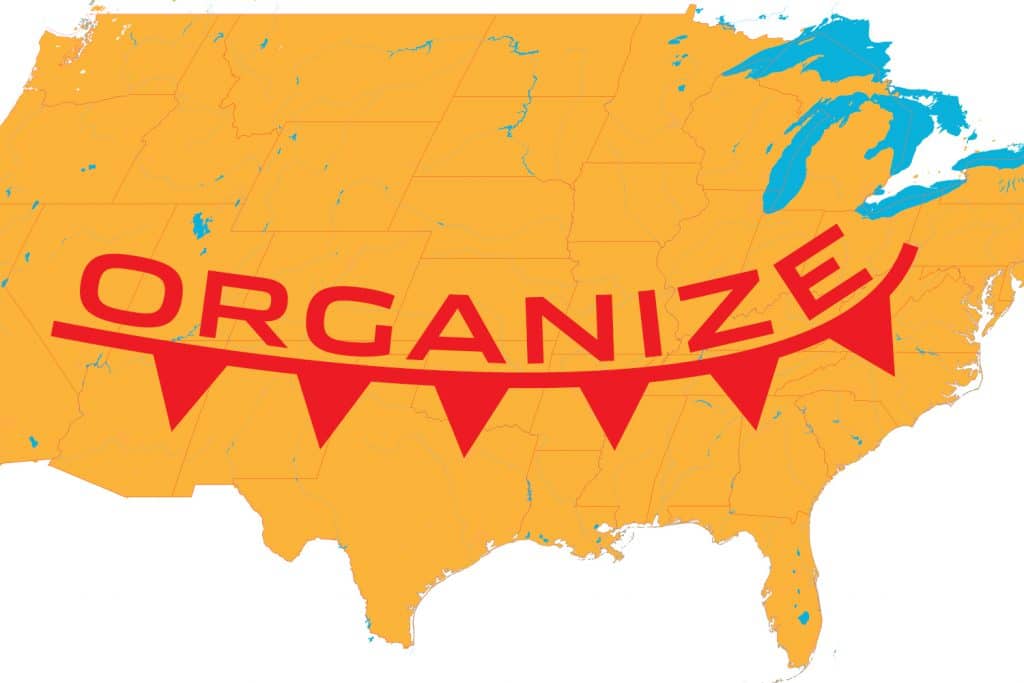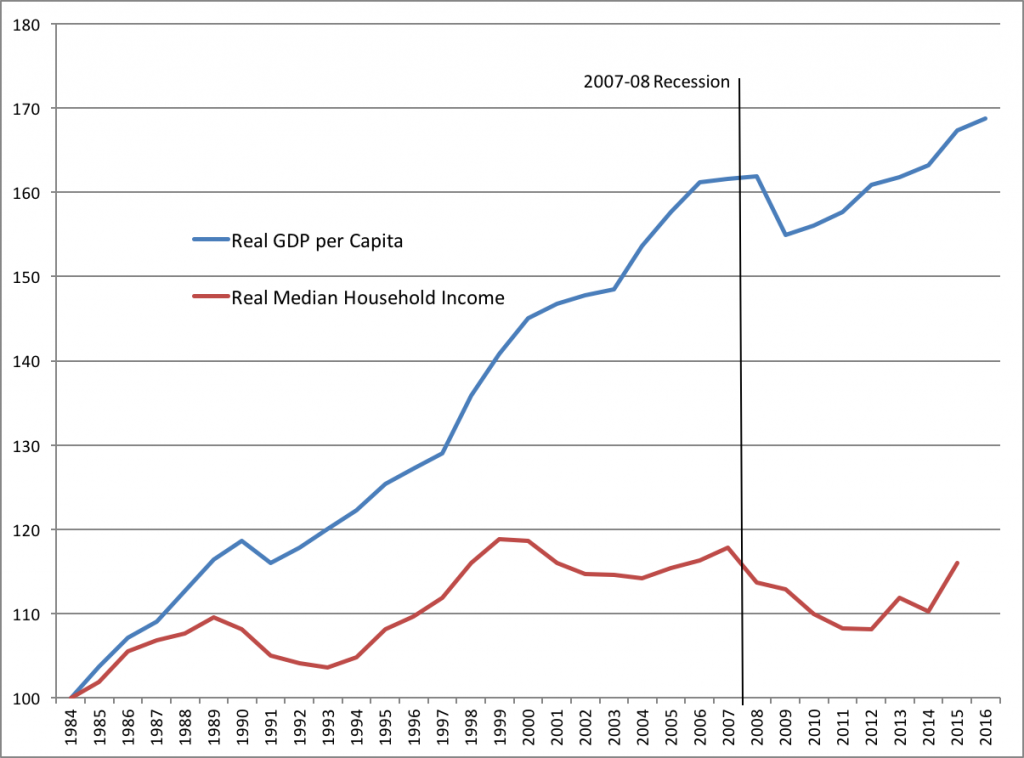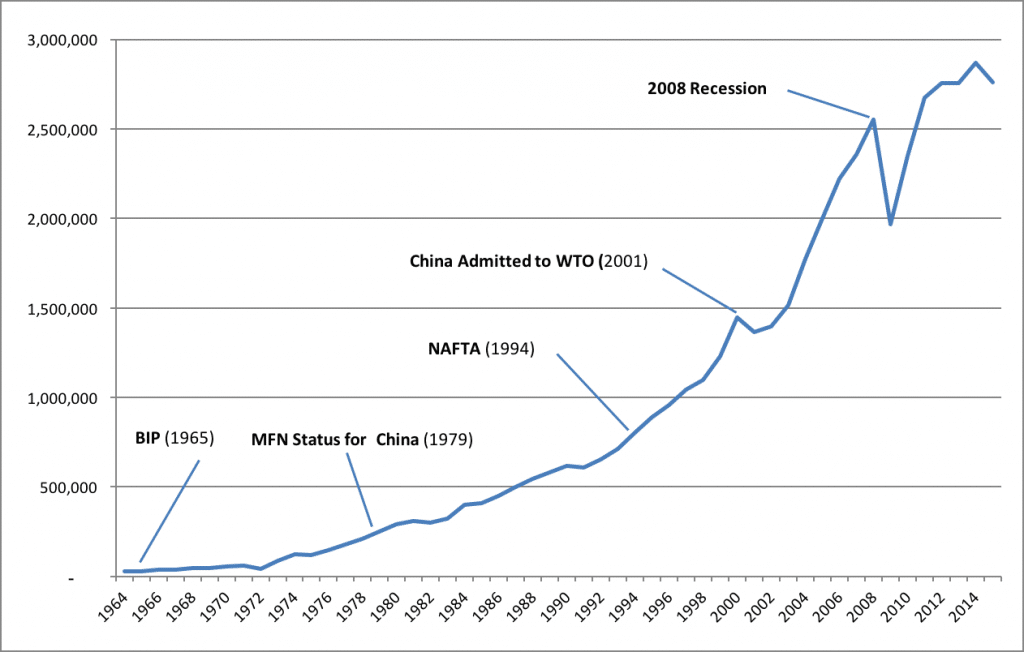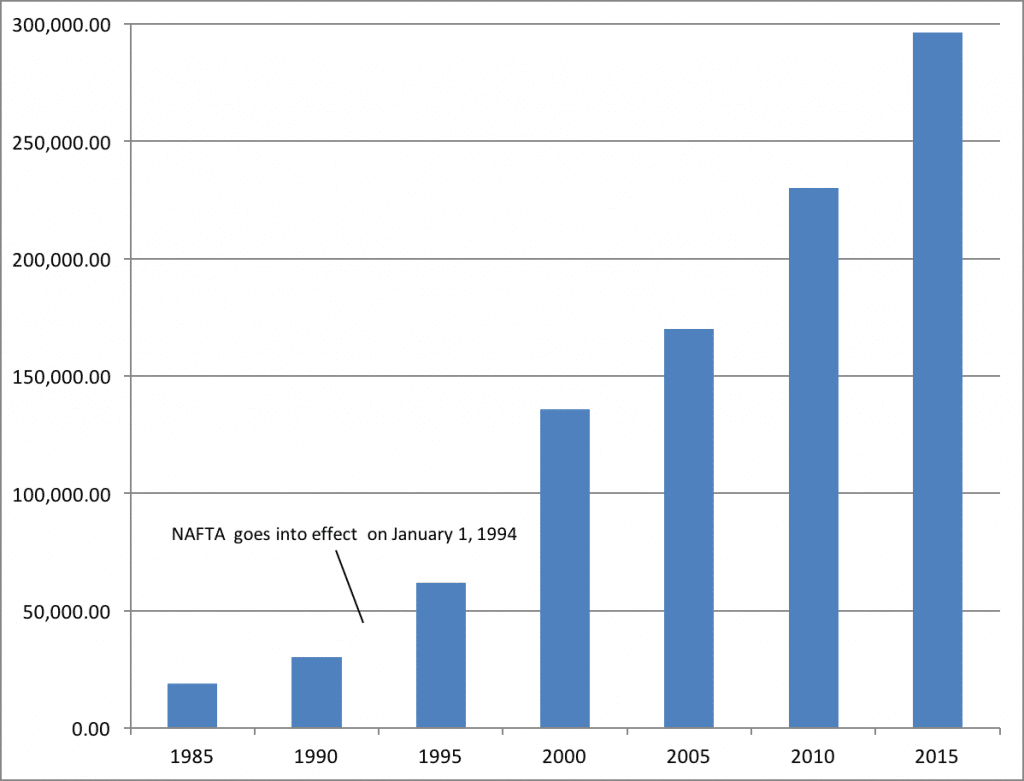This essay is an update of The Fight of our Lives: The War of Attrition against U.S. Labor that was posted on MRzine in 2007 and used as an organizing pamphlet in several Midwest auto plants that were eventually shuttered and dismantled after operations were moved offshore—the working class lost that battle but the war goes on! —Richard Vogel
Work in the 21st Century
The major contradiction for working people in the USA in the 21st century is now abundantly clear—while working for a living is a necessity for the majority of Americans and the wealth of the nation continues to grow, real wages and the number of decent jobs are in steady decline. Chart 1 clearly illustrates this contradiction.
Chart 1. Index of Growth in US Real GDP per Capita and Real Median Household Income, 1984-2016 (1984=100)
The chart shows two of the standard measures of income adjusted for inflation and population increase: real per capita Gross Domestic Product (GDP) and real median household income. It is clear that during the last three decades the per capita GDP has steadily increased while median household income peaked in 1999 and has remained stagnant since. The only significant dip in GDP occurred during the recession of 2008. While GDP has rebounded, real household income dropped simultaneously but has not recovered.
There is no mystery here— the offshoring of manufacturing and service industry jobs, the advances of automation and Information technology, the expansion of guest worker programs, and the increasing use of permanent-temporary employees (“permatemps”) have hollowed out the job market and undermined the position of working people vis-à-vis capital.
The purpose of this essay is to review how offshoring, the primary cause of the decline of the working class in the USA, also decimated unions, and to explore the prospect of rebuilding the American labor movement.
Offshoring
Over the last 50 years, the practice of offshoring in order to reduce labor costs and undermine labor unions turned the tide of class struggle against the working class. Chart 2 plots milestones in the history of offshoring in the US.
Chart 2. Total Imports of Goods and Services, 1964-2015 (millions of U.S. dollars)
This graph tracks the importation of goods and services into the USA from 1964 through 2015. While the value of imports is not a direct indicator of offshoring, it is a measure of the value of consumer and capital goods and services that could have been produced in the United States. The name and date of key policy changes with respect to offshoring are indicated along the import trend line in Chart 2.
1965: The Border Industrial Program
The Border Industrialization Program (BIP) was developed and promoted by US capital to tap the Mexican workers who had been deported from the United States at the end of the Bracero Program in 1964 and remained concentrated along the border in northern Mexico. The BIP opened this Mexican labor market to exploitation by American business. Initially light manufacturing firms moved across the Rio Grande but they were soon followed by high-tech and heavy industries which penetrated even deeper into Mexico.
A glance at the trend line in Chart 2 shows that the BIP marked the beginning of a growing influx of imported goods and services which has continued into the 21st century.
1979: Most Favored Nation
With the granting of Most Favored Nation status (MFN) to China by the USA, the stream of imports became a flood, approaching $600 billion a year by the end of the next decade. MFN status granted Chinese manufacturers access to US consumer and capital goods markets while opening Chinese labor and financial markets to US companies—a boon for American industries and finance capital but another blow to the US working class.
1994: NAFTA
The implementation of NAFTA promoted the consolidation of American capital in Mexico and insured a steady increase in imports to United States markets. Chart 3 documents the skyrocketing trend of imports after NAFTA that continues to escalate.
Chart 3. Value of Import of Goods from Mexico, 1985-2015 (millions of U.S. dollars)
The statistics here are overwhelming—the current value of imports from Mexico is 900% more than the value of imports before NAFTA. It has been a zero sum game for American labor—what is produced south of the border is not produced by US workers.
2001
The admission of China (sponsored by the USA) to the World Trade Organization (WTO) guaranteed China increased access to US commodity markets in exchange for expanded openings of Chinese financial, service, and labor markets. The resulting tsunami of imports subsided during the recession of 2008 but quickly recovered and reached $2.8 trillion in 2015.
The devastating impact of offshoring on the American labor market should not be underestimated. To appreciate it we can focus on the year 2013. If we take the $2.3 trillion total imports of goods alone for that year and divide it by the annual average product of labor in the American manufacturing sector ($150,000 per worker per year in 2013 according to the US Bureau of Economic Analysis) it would equal 153 million additional jobs—a number approaching the total official domestic labor force in the same year (155 million according to the US Bureau of Labor Statistics). Even though this estimate is speculative it does give us some idea of the impact of offshoring on the American labor market.
A corollary to the meteoric rise of foreign outsourcing in the United States economy has been the unprecedented decimation of the American working class and its communities as witnessed by the spread of the infamous Rust Belt that began in the 1980s in Northeastern, Great Lakes, and Midwestern states and eventually spread to every city in the USA that had manufacturing industries. And, of course, the nation has still not recovered from the resultant economic decline, population upheaval, and urban decay.
Predictably, offshoring had a devastating impact on US labor unions.
The Decline of US Labor Unions
Historically, organized labor has been the primary force mediating the distribution of wealth in capitalist nations, and the decline of labor unions in the USA has contributed to the stagnation of income depicted in Chart 1. Chart 4 illustrates their waning power:
Chart 4. Imports and Union Membership, 1964-2015

Sources: U.S. Census Bureau, Economic Indicators Division; U.S. Bureau of Labor Statistics, Current Population Survey
In this chart the rising trend of imports (from $27 billion in 1964 to $2.7 trillion in 2015) is superimposed over the falling trend in union membership (29.3 percent of the labor force in 1964 to 11.1 percent in 2015). Union membership percentages reported in Chart 4 are national averages. Map 1 records the damage state by state.
Map 1. Percentage of Workers in Unions, 1964/2015
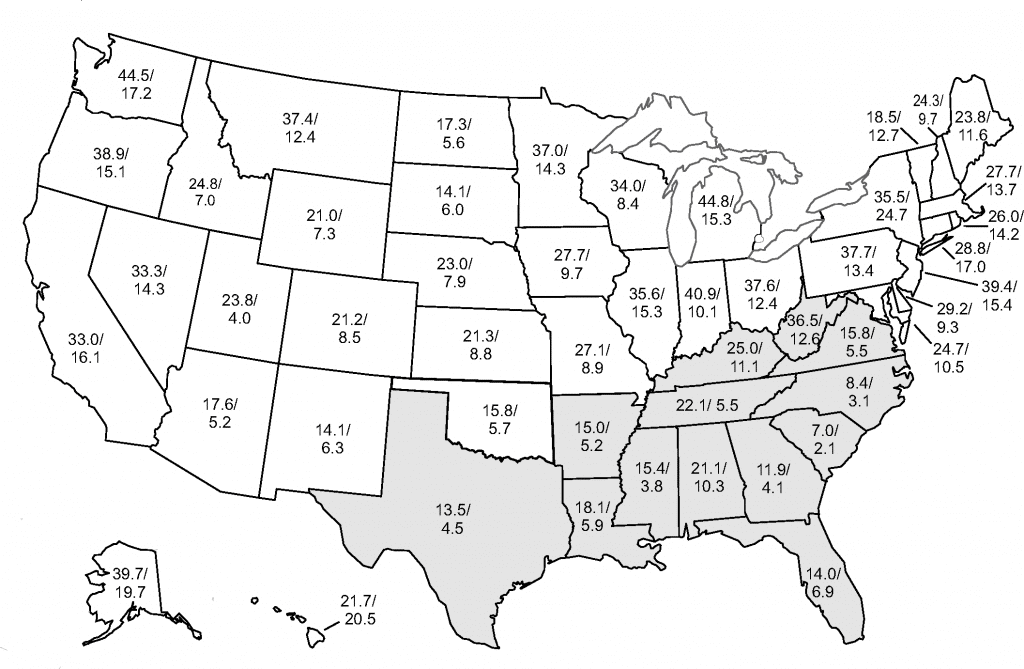
Source: Barry T. Hirsch, David A. Macpherson, and Wayne G. Vroman, “Estimates of Union Density by State,” Monthly Labor Review 124, no. 7, July 2001, pp. 52-55.
In the original core manufacturing states (Illinois, Indiana, Ohio, Michigan, Pennsylvania, New York, and New Jersey) average union membership was at its height in 1964 at 38.8 percent and currently stands at 15.0 percent. The highest average union membership in the Deep South (North and South Carolina, Georgia, Alabama, Mississippi, Louisiana, and Texas) during the same period was 13.6 percent and currently stands at 4.8 percent.
These regional differences in union participation and experience are a critical factor in the newest wave of globalization—nextshoring.
Nextshoring and the Southern States
In the initial wave of offshoring to Mexico and Asia, labor costs were the primary consideration of capitalists but that is no longer the case. In the current global strategy of nextshoring labor costs are still crucial, but government subsidies, proximity to markets, and reliable supply chains are also important considerations in corporate decisions about where to locate manufacturing operations. Nextshoring is well underway and with the current pressures of rising wages in the developing world and domestic pressure to reshore manufacturing and restore jobs for American workers, no issue is more important for organized labor to understand than this latest strategy of globalization—it provides the best opportunity to rebuild the labor movement in America.
The evolution of nextshoring in the United States dates back to the 1980s and is documented by the history of Toyota Motor Manufacturing (TMM), USA. TMM entered the country in northern California in 1984 through a joint venture with General Motors, New United Motor Manufacturing, Inc. (NUMMI).
Soon after the company established this beachhead in North America and developed supply chains to Asia, it moved into the southern US states: Kentucky (1986), West Virginia (1990), Alabama (2001), Texas (2003), and Mississippi (2007). In 2010, Toyota shut down NUMMI and shifted production to its plants in Texas and Tijuana, Mexico.
Toyota proved to be a pioneer in the strategy of nextshoring in North America. With each move the company strengthened its position in the lucrative US auto market. Optimizing the use of non-union labor, negotiating generous subsidies from state and local governments, and extending its supply chains, TMM has established itself as a leader in this latest version of globalization.
Many global corporations have followed Toyota’s lead.
The case of Airbus USA shows how nextshoring works. “With final assembly plants in Europe, China, and the US,” the company declares on its website, “the sun never sets on Airbus manufacturing.” Airbus is headquartered in Toulouse, France and has fully owned subsidiaries in Europe, China, Japan, India, the Middle East, and the United States. It is the American assembly plant that is of primary concern to US labor.
The Airbus Final Assembly Line is strategically located adjacent to the Mobile Aeroplex at Brookley just south of Mobile, Alabama in order to tap the cheap, non-union labor of the Deep South, for proximity to the North American market where more than 1,900 Airbus aircraft have been ordered, and to facilitate supply chains through the Aeroplex and the Port of Mobile. In order to seal the deal, state and local subsidies totaling $158.5 million were paid directly to Airbus. The value of indirect subsidies, like tax abatements, land deals, and extensive infrastructure improvements, is currently unreported.
Airbus USA directly employs 1,100 workers and, with hundreds of suppliers, claims to support 245,000 jobs in more than 40 US states, making it a prime target for union organizing.
The nextshoring boom in the area is extensive. Airbus USA is located just 6 miles down Mobile Bay from Austal US, a subsidiary of an Australian shipbuilding company constructing ships for the US Navy. The Australians set up operations in the Deep South for the same reasons Airbus did.
Not all the corporations nextshoring in the American South are foreign owned. Boeing, the world’s largest aerospace company based in Chicago, established a runaway manufacturing facility in Charleston, South Carolina in order to undercut unions on the West Coast and stay competitive with Airbus.
Table 1 offers an overview of the current scope of nextshoring in the American South.
Table 1. The Southern Labor Front
| State (City) | Company | Type of Manufacturing | Direct Employment | Indirect Employment |
| Alabama (Mobile) | Airbus | Aircraft | 1,100 (US total) | 245,000 (US total) |
| Alabama (Mobile) | Austal | Shipyard | 4,000 | 10,855 |
| Alabama (Lincoln) | Honda | Auto | 4,500 | N/A |
| Alabama (Montgomery) | Hundai | Auto | 2,500 | N/A |
| Alabama (Vance) | Mercedes | Auto | 3,500 | N/A |
| Alabama (Dotham, Tuscaloosa) | Michelin | Tires | 22,000 (US total) | N/A |
| Alabama (Huntsville) | Toyota | Auto | 136,000 (US total) | N/A |
| Alabama (Calvert) | AM/NS | Steel | 2,300 | N/A |
| Alabama (Mobile) | BAE | Shipyards | N/A | N/A |
| Georgia (West Point) | Kia | Auto | 14,000 | direct and indirect |
| Georgia (Covington) | Michelin | Tires | See US total above | N/A |
| Kentucky (Louisville) | Ford | Auto | 8,700 | N/A |
| Kentucky (Louisville) | GE | Appliances | 6,000 | N/A |
| KentucY (Bowling Green) | GM | Auto | 839 | N/A |
| Kentucky (Louisville) | Michelin | Tires | See US total above | N/A |
| Kentucky (Georgetown) | Toyota | Auto | See US total above | N/A |
| Mississippi (Canton) | Nissan | Auto | 6,400 | N/A |
| Mississippi (Tupelo, Blue Springs) | Toyota | Auto | See US total above | N/A |
| North Carolina (Charlotte) | Jen-Wen[i] | Windows and doors | Presently relocating | N/A |
| North Carolina (Whitsett) | Lenovo[ii] | Eletronics | 770 | N/A |
| North Carolina (Norwood) | Michelin | Tires | See US total above | N/A |
| North Carolina (Durham) | Toyota | Auto | See US total above | N/A |
| South Carolina (Greer) | BMW[iii] | Auto | 8,800 | N/A |
| South Carolina (Charleston) | Boeing | Aircraft | 7,565 | N/A |
| South Carolina (Camden) | Haler | Appliances | 410 | N/A |
| South Carolina (Spartanburg) | Michelin | Tires | See US total above | N/A |
| South Carolina (Charleston) | Volvo[ii] | Auto | Under construction | N/A |
| Tennessee (Spring Hill) | GM | Auto | 3,679 | N/A |
| Tennessee (Smyrna) | Nissan | Auto | 8,400 | N/A |
| Tennessee (Jackson) | Toyota | Auto | See US total above | N/A |
| Tennessee (Chattanooga) | VW | Auto | 3,200 | 9,500 |
| Texas (Arlington) | Boeing | Aircraft | 4,167 | 45,000 |
| Texas (Arlington) | GM | Auto | 4,125 | N/A |
| Texas (San Antonio | Toyota | Auto | See US total above | N/A |
| Virginia (Herndon, Ashburn) | Airbus | Aircraft | See US total above | See US total above |
| West Virginia (Buffalo) | Toyota | Auto | See US total above | N/A |
| Approximate totals | 261,000 | 1,000,000[iv] | ||
| Source: Statistics gathered from company and various state and industry websites.
[i] Currently relocating from Oregon [ii] Currently under construction [iii] Largest BMW factory outside of Germany [iv] This is most certainly a conservative estimate considering the fact that Airbus estimates that their US operations support 245,000 indirect jobs. |
||||
The southern states are the logical destination for companies that have adopted the strategy of nextshoring. In addition to the availability of cheap, non-union labor, southern states are governed by pro-business, anti-union administrations, are close to key American markets, and provide convenient port access on either the Atlantic or Gulf Coast—and all of these states are willing to spend large amounts of public money to offer exorbitant subsidies.
The size of capital investment in the South—in 2013, with $1 billion already invested in its South Caroline plant, Boeing announced a $1 billion expansion plan—indicates that nextshoring is the wave of the future.
In view of the current boom of nextshoring in the southern US, it is obviously a (perhaps the) key battleground for rebuilding the American labor movement. Success on the southern labor front would openly challenge the corporate strategy of nextshoring and galvanize the American labor movement.

